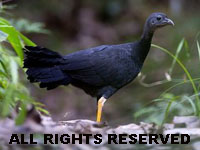BIRDS of THE WORLD - An Online Bird Book
GALLIFORMES
Guineafowls
Order Galliformes Family Numididae
GALLIFORMES
Galliformes are heavy-bodied ground-feeding domestic or game birds. Most are plump-bodied with thick necks and moderately long legs, and have rounded and rather short wings. They do not fly well if at all, but walk and run instead for transportation. These birds vary greatly in size from 12-120 cm. Many adult males have one to several sharp horny spurs on the back of each leg, which they use for fighting. They can be found worldwide and in a variety of habitats, including forests, deserts, and meadows. Male courtship behavior includes elaborate visual displays of plumage. Gallinaceous birds feed on a variety of plant and animal material, which may include fruits, seeds, leaves, shoots, flowers, tubers, roots, insects, snails, worms, lizards, snakes, small rodents, and eggs.
Guineafowls
Order Galliformes Family Numididae
Genus Acryllium - 1 species
Guineafowl, Vulturine Acryllium vulturinum Found: Africa
The Vulturine Guineafowl resembles a vulture because of it small bare skinned head with blue face; cobalt blue breast; rest of body black.
Image by: 1) Egg - Prague Zoo 2) Steve Garvie - Buffalo Springs National Park, Kenya 3) Dick Daniels - Sylvan Heights 4) Carol Foil - Buffalo Spring Reserve, Samburu District, Kenya

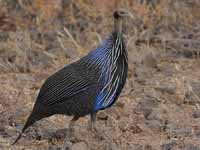
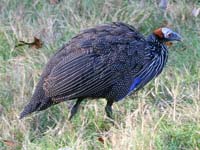

Genus Agelastes
Guineafowl, Black Agelastes niger Found: central Africa
The Black Guineafowl has mainly black plumage; unfeathered head, upper-neck. Males have 1 to 3 spurs per leg; female none or one small spur.
Image by: 1) Daniel_Elliot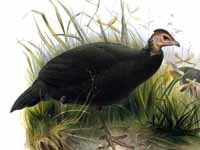
Guineafowl, White-breasted Agelastes meleagrides Found: western Africa
The White-breasted Guineafowl has mainly black plumage; white breast; small reddish bare head.
Image by: 1) Daniel_Elliot 2) webrun.it
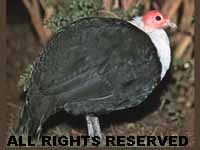
Genus Guttera
Guineafowl,_Crested Guttera pucherani Found: sub-saharan Africa
The Creset Guinefowl has dull gray-blue face, neck; curled (not not straiht) black creast,
Similar to: Plumed Guineafowl. Crested Guineafowl has straighter and higher creast than Plumed Guineafowl.
Image by: 1) Derek_Keats 2) Peter_Steward- Kenya 3) eboy 4) Heather_PaulSimilar to: Plumed Guineafowl. Crested Guineafowl has straighter and higher creast than Plumed Guineafowl.




Guineafowl, Plumed Guttera plumifera Found: central Africa
The Plumed Guinefowl has dull gray-blue face, neck; relatively long gray-blue wattle on either side of bill; straight (not curled) black creast,
Similar to: Crested Guineafowl. Crested Guineafowl has straighter and higher creast than Plumed Guineafowl.
Image by: 1) Daniel Elliot 2) Arjan Haverkamp 3) P_KhooSimilar to: Crested Guineafowl. Crested Guineafowl has straighter and higher creast than Plumed Guineafowl.



Genus Numida - 1 species
Guineafowl,_Helmeted Numida meleagris Found: Africa. Introduced: North America, Europe, Asia
The Helmeted Guineafowl has a round body and small head. The body plumage is gray-black spangled with white. It has an unfeathered head, decorated with a dull yellow or reddish bony knob, and red and blue patches of skin. The wings are short and rounded, and the tail is short.
Image by: 1) Arno Meintjes 2) Dick
Daniels - Tanzania 3) Dick - San Diego Zoo 4) Dick - Sylvan Heights 5) Dick - Featherdale 6) Sandy Cole near Kruger National Park in South Africa 7) Dick - Nairobi National Park, Kenya 8) NewJerseyBirds 9) Video by Avibirds. More vidoes3, 4) Numida m. reichenowi - found Kenya, Tanzania 6) Numida m. coronatus - found South Africa
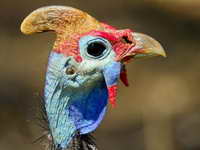








The megapodes, also known as incubator birds or mound-builders, are stocky, medium-large chicken-like birds with small heads and large feet in the family Megapodiidae. Their name literally means "large foot" and is a reference to the heavy legs and feet typical of these terrestrial birds. Megapodes are superprecocial, hatching from their eggs in the most mature condition of any birds. They hatch with open eyes, bodily coordination and strength, full wing feathers and downy body feathers, and are able to run, pursue prey, and, in some species, fly on the same day they hatch.
Genus Aepypodius
Brushturkey,_Waigeo Aepypodius bruijnii Found: near New Guinea on Waigeo Island
The male Waigeo Brushturkey has brownish-black plumage; bare red facial skin; red comb; maroon rump; chestnut-brown underpart; 2 red wattles at back of head and longer wattle on foreneck. Female has smaller comb and no wattles. It is endangered.
Image by: 1) Biodiversity_Heritage_Library
Brushturkey,_Wattled Aepypodius arfakianus Found: New Guinea
Image by: 1) Katerina_Tvardikova 2) Bernard_Dupont


Genus Alectura - 1 species
Brush-Turkey,_Australian also Australian Brushturkey Alectura lathami Found: Australia
During breeding season, the male Australian Brushturkey's wattle becomes bigger and redder.
Image by: 1) Charlie Westerinen near Brisbane Australia 2, 3, 4, 5) Dick Daniels - Sylvan Heights Waterfowl Park 6) JJ_Harrison1) Juvenile



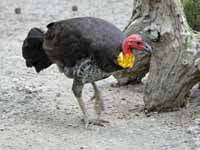


Genus Eulipoa - 1 species
Scrubfowl,_Moluccan Eulipoa wallacei Found: Indonesia
The Moluccan Scrubfowl has olive-brown upperparts; bluish-gray underparts; white under-tail; bare pink facial skin; bluish-yellow bill; dark olive legs.
Image by: 1) Sam_Woods
Genus Leipoa - 1 species
Malleefowl Leipoa ocellata Found: Australia
The Malleefowl's eggs are placed in a male-made mound that contains oraganic material. The decaying material produces heat which keeps the eggs warm. The chicks hatch, dig upward through the mound, and take total care of themselves.
Image by: 1) butupa 2) Dave_Curtis 3) Donald Hobern - Victoria 4) kr.afol 



Genus Macrocephalon - 1 species
Maleo Macrocephalon maleo Found; Sulawesi of Indonesia
The Maleo has mainly black plumage; bare yellow facial skin; dark casque on head; black upper-breast' rest of underparts are white. The Maleos eggs are placed in a hole in the sand where they can incubate via solar energy. The decaying material produces heat which keeps the eggs warm. The chicks hatch, dig upward through the mound, and take total care of themselves.
Image by: 1) Ariefrahman
Genus Megapodius
Scrubfowl do not incubate their eggs with their body heat in the orthodox way, but bury them. They are best known for building a massive mound of decaying vegetation, which the male attends, adding or removing litter to regulate the internal heat while the eggs hatch.
Scrubfowl,_Biak Megapodius geelvinkianus Found: Biak and other small islands near New Guinea
The Biak Scrubfowl has mainly dark gray plumage; slight crest; reddish or blusish face; red or dark gray legs.
Image by: 1) Ralf_Darius
Scrubfowl,_Dusky Megapodius freycinet Found: Maluku and Raja Ampat Islands near New Guinea
The Dusky Scrubfowl has dusky black plumage; dark legs; yellow bill,.
Image by: 1) Nicolas_Huet 2) Hanom_Bashari

Scrubfowl,_Melanesian Megapodius eremita Found: New Guinea, Solomon Islands
Image by: 1) David Cook

Scrubfowl,_Micronesian Megapodius laperouse Found: Micronesia
The Micronesian Scrubfowl has mostly brownish-black plumage; pale gray crest; yellow bill; red facial skin; yellow legs.
Image by: 1) Michael_Lusk - Northern Mariana Islands
Scrubfowl,_Niuafoou Megapodius pritchardii Found: Tonga
Image by: 1) Joseph_Wolf

Scrubfowl,_Nicobar Megapodius nicobariensis Found: Nicobar Islands
The Nicobar Scrubfowl has dark brown plumage; gray head; rufous crest; reddish facial skin.
Image by: 1) Sandeep_Dhumal
Scrubfowl,_Orange-footed Megapodius reinwardt Found: Austalia
Image by: 1) Toby Hudson - Queensland, Australia 2) David Cook - Cairns, Queensland 3) Jerry_Oldennettel - Cairns



Scrubfowl,_Philippinealso Tabon Scrubfowl Megapodius cumingii Found: Borneo, Sulawesi, Philippines
Image by: 1) Jason Thompson - North Sulawesi 2) Francesco_Veronesi - Palawan, Philippines

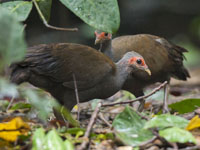
Scrubfowl,_Sula Megapodius bernsteinii Found: Banggai and Sula Islands near Sulawesi, Indonesia
The Sula Scrubfowl has uniform reddish-brown plumage; short pointed crest; red or orange-red legs.
Image by: 1) Frank_Rheindt
Scrubfowl_Tanimbar Megapodius tenimberensis Found: Tanimbar Islands of Indonesia
The Tanimbar Scrubfowl is sometimes considered a subspecies of the Orange-footed Scrubfowl.
Image by: 1) Fahrul_Amama
Scrubfowl,_Vanuatu Megapodius layardi Found: Vanuatu (northeast of Australia)
Image by: 1) Ogilvie-Grant

Scrubfowl,_New_Guinea Megapodius decollatus Found: New Guinea
Image by: 1) Joseph Smit

Genus Talegalla
Brushturkey,_Red-billed Talegalla cuvieri Found; New Guinea
The Red-billed Brushturkey has mainly black plumage; reddish-orange bill; yellow facial skin; yellow eyes; orange feet.
Image by: 1) hbw.com
Brushturkey,_Red-leggedalso Colared Brushturkey Talegalla jobiensis Found; northern New Guinea
Image by: 1) pinned
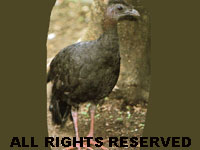
Brushturkey,_Yellow-legged also Black-billed Brushturkey Talegalla fuscirostris Found; Aru Islands and New Guinea
The Yellow-legged Brushturkey has black plumage, bill; yellow legs.
Image by: 1) Pinned